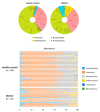Characterization of Gut Microbiome in Korean Patients with Metabolic Associated Fatty Liver Disease
- PMID: 33801023
- PMCID: PMC8004024
- DOI: 10.3390/nu13031013
Characterization of Gut Microbiome in Korean Patients with Metabolic Associated Fatty Liver Disease
Abstract
Metabolic associated fatty liver disease (MAFLD) is a new concept where the presence of both fatty liver and metabolic abnormality are necessary for diagnosis. Several studies have reported that altered gut microbiome is closely associated with metabolic diseases and non-alcoholic fatty liver disease. However, the studies on MAFLD population are scarce. This prospective study aimed to identify differences in gut microbiome between patients with MAFLD and healthy controls in Korean population. In this study, patients with MAFLD and age, sex-matched healthy controls were included, and their stool samples were collected. Taxonomic composition of gut microbiota was analyzed using 16S ribosomal ribonucleic acid pyrosequencing. Twenty-two MAFLD patients and 44 healthy controls were included. Taxonomic diversity was lower in patients with MAFLD in the aspect of alpha and beta diversity. The differences were also found at phylum, class, family, and genus levels between the two groups. Phylum Proteobacteria, family Enterobactereriaceae, genus Citrobacter abundance was significantly increased and genus Faecalibacterium was significantly decreased in patients with MAFLD. In addition, butyrate-producing bacteria were decreased and ethanol-producing bacteria were increased in patients with MAFLD. The composition of gut microbiome was different between MAFLD and healthy controls in Korean population. This could offer potential targets for therapeutic intervention in MAFLD.
Keywords: butyrate; ethanol; gastrointestinal microbiome; metabolic associated fatty liver disease; non-alcoholic fatty liver disease; short-chain fatty acids.
Conflict of interest statement
The authors declare no conflict of interest. The funders had no role in the design of the study; collection, analyses, or interpretation of data; writing of the manuscript; or the decision to publish the results.
Figures




References
-
- Eslam M., Newsome P.N., Sarin S.K., Anstee Q.M., Targher G., Romero-Gomez M., Zelber-Sagi S., Wai-Sun Wong V., Dufour J.F., Schattenberg J.M., et al. A new definition for metabolic dysfunction-associated fatty liver disease: An international expert consensus statement. J. Hepatol. 2020;73:202–209. doi: 10.1016/j.jhep.2020.03.039. - DOI - PubMed
MeSH terms
Substances
LinkOut - more resources
Full Text Sources
Other Literature Sources
Medical

